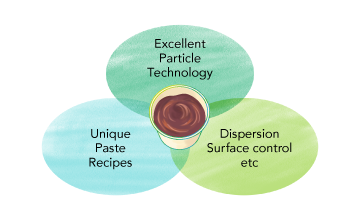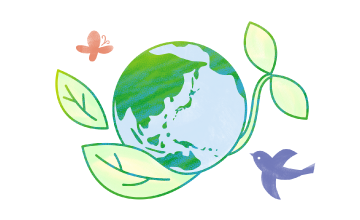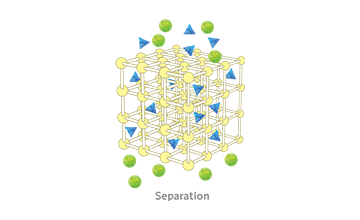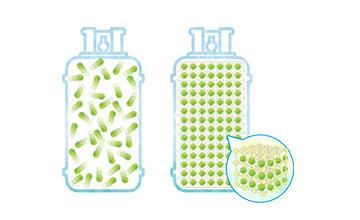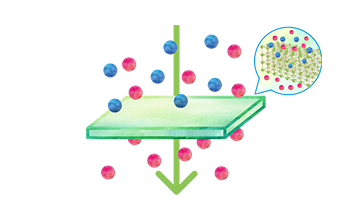MOFs, with their features to adsorb, separate, and convert carbon dioxide, are expected to contribute to solving environmental issues. Mitsui Kinzoku is exploring the potential of MOFs together with our collaborators. In the future, we will widely put MOFs into practical applications as a useful material.
What kind of changes will MOFs bring about with its commercialization?
In the field of batteries, which Mitsui Kinzoku has offered materials for years, it is possible to propose MOF as a novel material. We believe this could bring some advances to automobiles and smartphones. Furthermore, we believe that MOFs, with their ability to adsorb, separate, and convert carbon dioxide, can make a significant contribution to achieving carbon neutrality. Among their various features, I believe that those that help solve environmental problems are particularly vital.
So, are you currently considering to narrow down the direction of application exploration and development?
Well, I think now is too early to narrow down the direction. Of course, it is necessary to choose direction when we launch a full-scale business, but I don't want to cut off any possibilities just yet. Before that, I would like to promote more recognition of MOFs. I am looking forward to meeting clients and business partners who will work with our company through this initiative. We would like to be a leading company in MOFs by the time when MOFs are commercialized for various applications.
What is your vision for MOF use in 2030, 2040 and 2050?
Ideally, it should be used in products that contribute to solving environmental issues. One example is hydrogen. Even though it is still challenging to produce hydrogen gas using MOFs, they can purify it from other impurities. I hope that such efforts will spread throughout society.
The "surprise" and "excitement" generated by MOFs should be shared with consumers, which may lead to their greater social recognition and diffusion.
Since MOF is not a final product, it would be difficult for end users to recognize it. However, "I didn't know it, but it actually contains an amazing material!" may give a surprise to the users. Mitsui Kinzoku's existing products are actually contained in many products that are familiar to consumers.
What has made you excited through the development of MOF?
First of all, I was impressed by MOF itself. According to Prof. Kitagawa of Kyoto University, MOF was created by accident. When he looked closely at the material, which he considered it a failure at first, he found countless holes in it, and he realized its potential. Therefore, he said that this MOF is "the usefulness of the useless," meaning that it plays a very important role even though it seems to be useless at first glance. I was very moved by this expression as it was perfect for this material. It takes a very long time to commercialize brand-new materials. But start-ups like Atomis boldly take on these difficulties. It is becoming typical for such companies to team up with large companies like us. Although Japanese government is promoting support for startups, it is still less advanced than that in U.S. We should strengthen the support policy for start-ups, so that more innovative products will be created in Japan. It is our greatest pleasure to see end-users find convenience in these products.
I also remember the time when our collaboration with Atomis just begun. The MOF project has now become one of the hottest topics in the company. Moreover, some younger colleagues studied MOFs at college. However, we were a very small team at the beginning. We rented a room in a facility near Atomis’ laboratory in Kyoto. This is how it all started. While learning about MOFs from Atomis in the Kyoto laboratory, we started experiments with small devices and worked on scale-up. I will never forget those early years: we literally worked together, face-to-face, over drinks. When Atomis asked us to help them to handle a large order, I synthesized MOFs by pouring solvent into a bucket in the lab.
"Cutting-edge technology" sounds sophisticated, but the actual development must be an uphill battle.
It must be true. I once tipped over a bucket while working with it. The whole room was filled with smelly vapor of organic solvent. All in all, it was exceptionally exciting because we started the project on an equal basis, regardless of the size of the company. Still, both entities followed the policy of "good fences make good neighbors" being committed to complying with contracts, quality inspections, and the like.
You are convinced that further innovation will continue to be created through collaboration with outside parties, as the MOF project, aren’t you?
Absolutely. Combination of materials can greatly expand their possibilities. While many companies have recently been promoting open innovation, I believe it will be more important to cooperate with other entities, rather than being self-reliant. In collaboration among multiple companies, mutual benefits are important, instead of one company monopolizing the market. I must say that this would be the key factor for making technologies with high potential to be valuable to the world.
Interviewee: Kazuo Matsumae, Co-creation Project Group Leader & MOF Project Leader, Market Co-creation Department, Business Creation Sector, Mitsui Mining & Smelting Co., Ltd.
(Date of interview: December 1, 2022)
(The company is hereinafter referred to as "Mitsui Kinzoku.")








